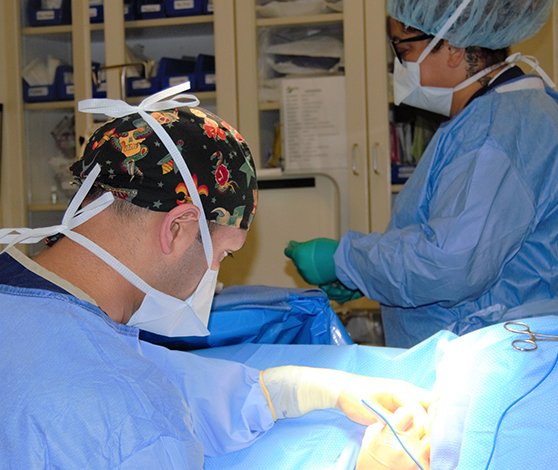Pancreatic Surgery Specialist
Surgery is a highly effective means of dealing with many common types of cancer. The doctors at Association of South Bay Surgeons are experienced in the diagnosis and staging (determining the extent) of cancer, and surgically treat many cancers safely and effectively.
Pancreatic Surgery Q & A
Pancreatitis is a condition that causes inflammation within the pancreas. This condition causes a number of issues, including pain in the upper abdomen, nausea, fever, bloating, and vomiting. In the acute version of pancreatitis, the condition can resolve fairly quickly and won’t require surgery. However, if the condition becomes chronic, the patient can experience malnutrition, extreme weight loss, and other serious symptoms. The pancreas can even be destroyed eventually, resulting in diabetes mellitus.
Pancreatic cancer is ranked as the 4th most common cause of cancer-related deaths among men, and the 5th most common cause of cancer-related deaths among women. Over 37,000 new cases of pancreatic cancer are diagnosed in the United States each year. Because there are no symptoms early on, pancreatic cancer is sometimes not diagnosed until it’s quite advanced. A painless yellowing of the skin (jaundice) is often the only symptom until the cancer is quite advanced. This type of cancer is unique in that it doesn’t respond well to common cancer treatments, like radiation and chemotherapy. However, if the cancer is identified early enough, surgical resection provides a very effective treatment. Even if the cancer isn’t diagnosed until a patient is in the later stages of the disease, surgical resection greatly improves a patient’s quality of life and gives them symptom relief.
Other pancreatic diseases that the team at Association of South Bay Surgeons treats regularly include pancreatic pseudocysts, pancreatic abscesses, and auto-immune pancreatitis.
At Association of South Bay Surgeons, an entire team of radiologists, gastroenterologists, pathologists, and medical and radiation oncologists work together to determine the best-individualized treatment plan for each patient. This includes minimally invasive laparoscopic surgeries, such as laparoscopic enucleation, laparoscopic distal/left pancreatectomy, laparoscopic pancreatic ablation, and laparoscopic and traditional Whipple Surgery (pancreaticoduodenectomy.) The surgeons at Association of South Bay Surgeons served as faculty at Penn State University and UCLA-Harbor and trained other surgeons to perform pancreatic surgery. They also researched and published about pancreatic diseases extensively. All of this makes Association of South Bay Surgeons a team with unparalleled experience.
Our board-certified & fellowship trained surgeons are skilled at diagnosing and treating pancreatic diseases including:
- Auto-Immune Pancreatitis
- Pancreatic Cancers such as Adenocarcinoma, Neuroendocrine / Islet cell carcinoma, Pseudopapillary neoplasms
Team Work & Individualized Therapy
Our team includes surgeons with advanced training (Fellowships) in Minimally Invasive Surgery and also Pancreatic Surgery & Surgical Oncology.
The best care requires radiologists, gastroenterologists, pathologists, and sometimes medical and radiation oncologists.
We work closely with these and other specialists to individualize a treatment plan for you.
Minimally Invasive / Laparoscopic Surgery & Pancreatectomy
We are experienced in minimally invasive / laparoscopic pancreatic surgery such as:
- Laparoscopic Enucleation
- Laparoscopic Distal / Left Pancreatectomy
- Laparoscopic Pancreatic Ablation
- Laparoscopic & Traditional Whipple Surgery (Pancreatico-Duodenectomy)
Unparallelled Experience
- Our surgeons have been faculty at Penn State University and UCLA- Harbor.
- We have trained other surgeons to perform pancreatic surgery.
Pancreatic Cancer Resources
Laparoscopic Surgery Specialist
Advanced laparoscopic surgery is the new era of modern surgery. The highly experienced physicians at Association of South Bay Surgeons use this surgical technique to deal with a wide variety of disease and illness. With the tiny incisions, recovery is much faster and easier than it would be with open surgery.
Advanced Laparoscopic Surgery
In laparoscopic surgery, the surgeon needs to create only 3-4 very small incisions in the treatment area to perform the necessary surgery. A gas — typically carbon dioxide — is introduced to the treatment area to expand it for viewing purposes. A laparoscope, a slender surgical tool that combines a telescope and a miniature camera, is inserted through the primary small incision. This gives the surgeon an extremely close-up and detailed view of the interior of the body without the need for major incisions. In the other tiny incisions, the surgeon inserts the surgical tools. This technique allows for surgeons to perform many different types of procedures in the least invasive way possible.
Advanced laparoscopic surgery techniques now allow for surgeons to access nearly any of the body’s organs for surgical treatment. Gallstones, once treatable only by removal of the gallbladder in open surgery, can easily be resolved with the laparoscopic removal of the gallbladder. This cuts the healing time drastically, with many people returning to their usual routine in only 5-10 days. The stomach, intestines, pancreas, spleen, kidneys, and female reproductive system can all be accessed through laparoscopic surgery. Most diseases and disorders that require surgical treatment can be treated with laparoscopic surgery.
There is far less trauma to the patient’s skin and muscles with laparoscopic surgery. Also, there is dramatically less bleeding, which greatly helps in recovery. Patients have less pain, which allows them to bounce back from the procedure much faster than they would with an open surgery. Many laparoscopic surgery patients walk around comfortably the same day of their procedure. Since the interior of the abdominal cavity isn’t exposed during surgery, there is also a lower infection rate with laparoscopic surgery. The high quality camera and high magnification allow the surgeon to see the most precise and expansive view of the surgical area possible, enabling them to see issues and potentially identify problems that might be harder to see with traditional open surgery.
Liver Surgery Specialist
Liver malfunctions may be caused by cysts, cancer, or something else. Prompt diagnosis and treatment is critical to maintain good health. The Association of South Bay Surgeons are experienced in this area, and they’re here to help. Call the office today for an appointment or consultation.
Liver Surgery
The liver is found on the right side of the body, beneath the ribcage and has a number of different functions. Not only does it store and filter the blood, it helps blood to clot, creates bile to aid in the digestion of proteins and fats, and converts sugar into energy. The liver is also a critical component in dealing with waste. When the liver isn’t functioning properly, there may be a number of reasons. Prompt treatment can make all the difference when it comes to long term wellness.
Liver cancer is a major liver problem. Malignant cancer of the liver can be the result of metastasis (spreading from other types of cancer located in other areas). Other liver cancer types include hepatocellular cancer and cholangiocarcinoma. Cysts, abscesses, and adenomas are also common causes of liver disease.
At Association of South Bay Surgeons, the goal is to provide patients with the least invasive liver disease and liver cancer treatment possible. Often, minimally invasive laparoscopic liver surgery, including ultrasound, resection, radiofrequency and microwave ablation, are performed to remove or destroy diseased liver tissue and allow healthy tissue to grow in its place.
In a liver resection, the portion of the liver with tumors is surgically removed. With a liver ablation, no liver tissue is surgically removed. Instead, high heat or electrical current is used to destroy the cancerous or diseased liver cells. In some cases, patients need a combination procedure that includes both a liver resection and an ablation to make sure that all the diseased or damaged tissue is dealt with properly.
The surgeon creates a group of small surgical incisions to allows them to use laparoscope and surgical tools. Generally, the incisions are only around 1/4 inch, with 1-2 larger incisions that allow for tissue removal, if needed.
It depends on the procedure. The shortest liver surgeries, usually ablations, can be around 2 hours. Longer surgeries that include both liver resection and ablation may last from 2-4 hours on average.
Our board-certified & fellowship trained surgeons are experienced at diagnosing and treating liver diseases including:
Benign diseases such as:
- Cysts & Abscesses
- Adenomas
Malignant cancers such as
- Metastasis (spread from other cancers)
- Hepatocellular Cancer (HCC)
- Cholangiocarcinoma
With the most current techniques and tools, we provide cutting edge & compassionate care.
Minimally Invasive / Laparoscopic & Traditional Options
- Minimally Invasive / Laparoscopic surgery reduces your pain, reduces your risk of complications, and speeds your recovery.
- Our team includes surgeons with advanced training (Fellowships) in Minimally Invasive Surgery and also Liver Surgery / Surgical Oncology.
We are experienced in minimally invasive / laparoscopic liver surgery such as:
- Laparoscopic Liver Ultrasound
- Laparoscopic Liver Resection / Hepatectomy
- Laparoscopic Tumor Microwave & Radiofrequency Ablation
Unparallelled Experience
- Our surgeons have been faculty at Penn State University and UCLA- Harbor.
- We have trained other surgeons to perform liver surgery.
- We have researched and published about these diseases extensively.
- We have written textbooks on liver surgery.
Resources
Surgeons

James E. Camel
MD, MS, FACS
Robotic & General Surgery


